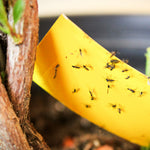Herbs are beautiful and lively - perfect "uplifting" plants for the winter.
Herbs bring year-round cheer to indoor and outdoor spaces, with uplifting fragrant oils and easy options for actually making use of the plants. However, even the best-intentioned gardener can end up disappointed if a couple of key guidelines are not followed when planning for fall and winter herbs indoors. So, here is a little cheat sheet to help! Stevia can be maintained indoors, under lights - particularly if snipped regularly to maintain bushiness.
Stevia can be maintained indoors, under lights - particularly if snipped regularly to maintain bushiness.
Tip # 1
Evergreen herbs from higher gardening zones are the easiest to maintain indoors. These are plants like stevia, bay leaf, lemongrass and galangal ginger which all are naturally inclined to stay leafy and actively growing without the need for a winter break. By contrast, cold-tolerant perennials like French tarragon, lovage and lemon balm require cold dormancy and are not easy to cajole into active growth over winter.
Tip # 2
Most herbs need long daylight hours in the form of direct sun. In fact, if there is one thing that makes indoor herb gardening more carefree it is to set up under full-spectrum grow lights. During the winter months on the prairies, there are simply too few hours of strong daylight to support active growth without supplemental lights.
There are a few herbs that are exceptions to the long, strong daylight requirement. Parsley, myrtle and galangal ginger are fabulous examples.
Tip # 3
Annual herbs such as basil, cilantro and dill are by far and wide easier to start fresh from seed indoors as opposed to bringing in summer-grown plants. These plants also require full-spectrum lights to grow satisfactorily between October and March. Mint LOVES regular cutting back, right to the soil level. This stimulates strong growth indoors, counteracting the tendency to otherwise go dormant during the winter months.
Mint LOVES regular cutting back, right to the soil level. This stimulates strong growth indoors, counteracting the tendency to otherwise go dormant during the winter months.
Tip # 4
If you do want to grow more **cold-tolerant evergreen herbs like mint, chives, thyme, sage, lavender and rosemary indoors then try to set up in the brightest yet cool location available indoors. Foyers, large windows, bay windows, 4-season sunrooms, attics and sometimes basements are ideal.
**cold tolerance is of course relative and some of these varieties may sound like warm climate plants... yet everything up to zone 7 does better with a little winter chill
Cooler climate plants still require lots of light but even more important is providing winter temperatures that contrast significantly with the summer heat. So there you have it. Choose warm climate herbs for indoor wintering, start fresh seedlings of annual herbs in fall, don't skimp on light and plan for a cool location for Mediterannean and cooler region plants. Following these key guidelines will make it so much easier to enjoy herbs year-round!
So there you have it. Choose warm climate herbs for indoor wintering, start fresh seedlings of annual herbs in fall, don't skimp on light and plan for a cool location for Mediterannean and cooler region plants. Following these key guidelines will make it so much easier to enjoy herbs year-round!
>> Want to learn more? Listen in to this throwback episode of the Grow Guide podcast for a detailed chat about growing herbs indoors! Click here for iTunes link
Originally posted on September 10, 2021







